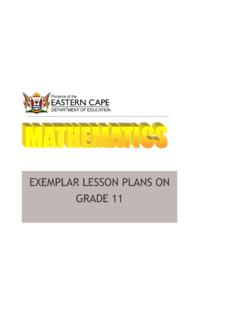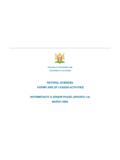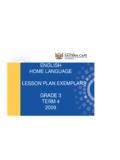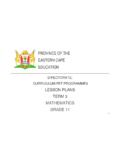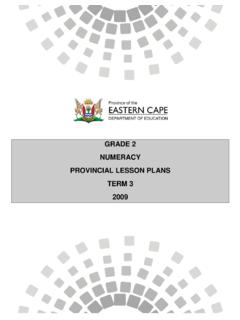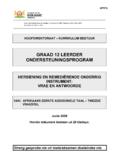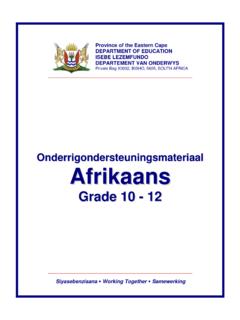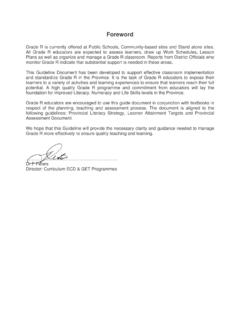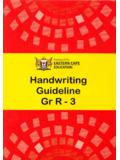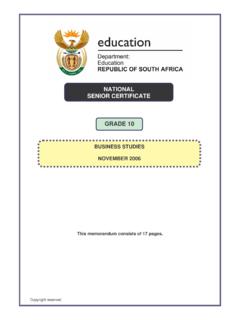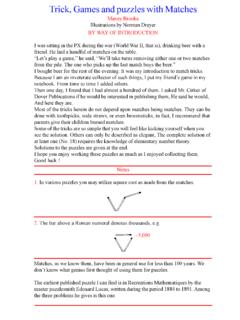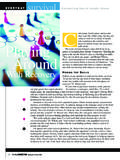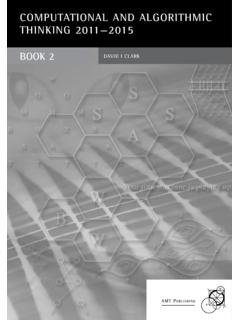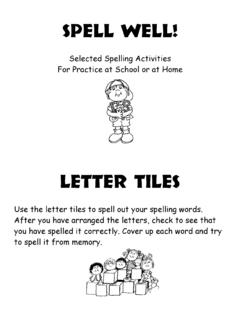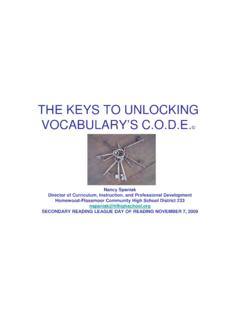Transcription of WORK SCHEDULE: ENGLISH FIRST ADDITIONAL LANGUAGE …
1 WORK schedule : ENGLISH FIRST ADDITIONAL LANGUAGE GRADE 8 TERM 1 Content in Context: Multi Media Texts Integration Across: Resources: TELEVISION PROGRAMMES, WEATHER FORECASTS (excluding Grade 7), ADVERTISEMENTS, FILMS AND VIDEOS, CD-ROMS and INTERNET (where available). Newspapers, Magazines, Poems, Play-scripts, Diaries, Postcards and Letters, Procedural texts ( instructions), Factual descriptions, Reports, Explanations, Textbooks from other Learning Areas, Advertisements, Notices, Posters, Book and Television reviews, Diagrams, Graphs and Charts, Reference books ( encyclopaedias) Messages ( phone messengers); Radio advertisements; Reports of events; Radio talks.
2 Talk Shows Term Learning Outcomes and Assessment Standards Assessment Teaching & Learning Strategies 1,2&3 Multi Media Texts LO 1 Listening AS 2 Understands oral texts ( poems, radio plays): answers questions of growing complexity identifies point of view; retells and summarises; describes the features or characteristics of different kinds of oral texts ( poem or factual text). Form; Written Products: Creative Writing Tests and examination Class work Composition/ Essay Paragraphs Exhibition and presentation Journal writing Project Written Response to text LANGUAGE Structure Advertisement Book report/ review Round robin Panels Jigsaw Numbered heads together Buzz groups Pairs Brainstorming Hot potato Gallery walk Rainbow groups Role- play Discussions De Bono s six thinking hats Questions and answers Debates Case study LO 2 Speaking AS 2 Interacts in ADDITIONAL LANGUAGE .
3 Uses LANGUAGE for a range of functions: offers and invites ( Would you like ..? ), politely refuses ( I m sorry .. ), etc.; takes part in role-plays of different situations involving different kinds of LANGUAGE ( reporting a crime to the police). AS 4 Debates social and ethical issues: shares roles ( chairperson, timekeeper, secretary); brings people into the discussion ( What do you think? , Don t you? ); interrupts politely ( Excuse ); expresses opinions and supports them with reasons ( I d just like to say that.)
4 ; expresses agreement ( You re right. ) and disagreement ( Yes, ); switches languages where necessary. LO 3 Reading & Viewing AS 3 Reads and responds to social texts ( personal letters, notices): identifies purpose, audience and context; describes features of the type of text being read ( a personal letter). Brochure Crossword puzzle Lab report Letter Magazine article Memo Newspaper article Poem Research report Questionnaire Other Oral Products: Role play Oral presentation Vocabulary Listening (Thinking & Reasoning) Reading Debates Demonstration Audio tape Discussion Dramatization Interview Play Poetry reading Rap Song Teach a lesson Other Storytelling Whole class activity Individual activity Group activity Investigation Problem solving activity Games Role play Facilitating Reading Other AS 5 Analyses photographs in texts ( advertisements and newspapers).
5 Identifies the subject, context, audience and message of the photo, identifies from whose point of view the photo has been taken; identifies what has been left out of the photo and why; judges whether the photo is memorable and gives reasons. AS 6 Uses reading strategies: matches different ways of reading to different texts ( scans a telephone directory); develops and evaluates reading speed; uses strategies to work out the meanings of words ( looks at illustrations or diagrams, and discusses the word in home LANGUAGE ). LO 4 Writing AS 2 Writes for social purposes: writes personal letters ( politely refusing an invitation), showing awareness of the text type, of purpose, audience and context, and of register/style; writes e-mail messages.
6 AS 3 Writes for personal reflection: writes a diary AS 5 Designs media texts: designs a simple advertisement or pamphlet Visual products: Advertisement Banner Cartoon Collage Collection Computer graphic Construction Design Diagram Display Drawing Graph Map Model Painting Photograph Poster Sculpture Slide show Story board Video tape Method: Self assessment Peer assessment Teacher assessment Tool: Memorandum Observation sheet/ book Checklist Rubric Journal writes a simple news report AS 7 Uses developing knowledge of LANGUAGE structure and use: makes a text cohesive ( using linking words to link paragraphs); writes good paragraphs with one main idea, a topic sentence and supporting sentences, and is able to reflect on it; writes introductions and conclusions; adopts a point of view.
7 LO 5 Thinking and Reasoning AS 2 Uses LANGUAGE for thinking: asks and answers more complex questions ( When this is changed, then what else would change? ); writes definitions, classifications and generalisations AS 3 Collects and records information in different ways: selects relevant material and takes notes (organises points under headings; abbreviates words); reads and synthesises information from two simple texts on the same topic; transfers information from one mode to another by, for example, using mind maps. Other LO 6 LANGUAGE Structure and use As 6 Uses modals to express politeness ( Can /Could I borrow a pencil ?)
8 AS 9 Expands vocabulary ( by mind mapping related words, such as words about war). AS 10 Demonstrates an understanding of between 5000 and 7500 common spoken words in context by the end of Grade 8. Learners, who will do someof their learning through their ADDITIONAL LANGUAGE , should aim for 7500 words.. Content in Context: Stories Integration Across: Resources: Stories; Fables; Legends; Descriptions of people and objects; Conversations; Prepared Talks; Books (fiction and non-fiction); Textbooks; Book Reviews; Photographs; Word Puzzles; Reference books; ( dictionaries, encyclopaedias) ; films and videos; CD-ROMS and INTERNET (where available).
9 Term Learning Outcomes and Assessment Standards Assessment Teaching & Learning Strategies 1 & 4 LO 1 Listening AS 1 Understands and appreciates stories, including those told by other learners: Responds personally and critically, asks and answers questions; Evaluates the storytelling technique and performance, and gives feedback. AS 2 Understands oral texts ( poems, radio plays): answers questions of growing complexity; identifies point of view; retells and summarises. AS 4 Listens actively in discussion: Shows openness to ideas and treats the views of others with respect; Invites contributions from others and responds to their views; Is prepared to challenge others but does so politely and does not interrupt them; Criticises the ideas and not the person.
10 Form; Written Products: Creative Writing Tests and examination Class work Composition/ Essay Paragraphs Exhibition and presentation Journal writing Project Written Response to text LANGUAGE Structure Advertisement Book report/ review Brochure Crossword puzzle Lab report Letter Magazine article Memo Round robin Panels Jigsaw Numbered heads together Buzz groups Pairs Brainstorming Hot potato Gallery walk Rainbow groups Role- play Discussions De Bono s six thinking hats Questions and answers Debates Case study Storytelling
